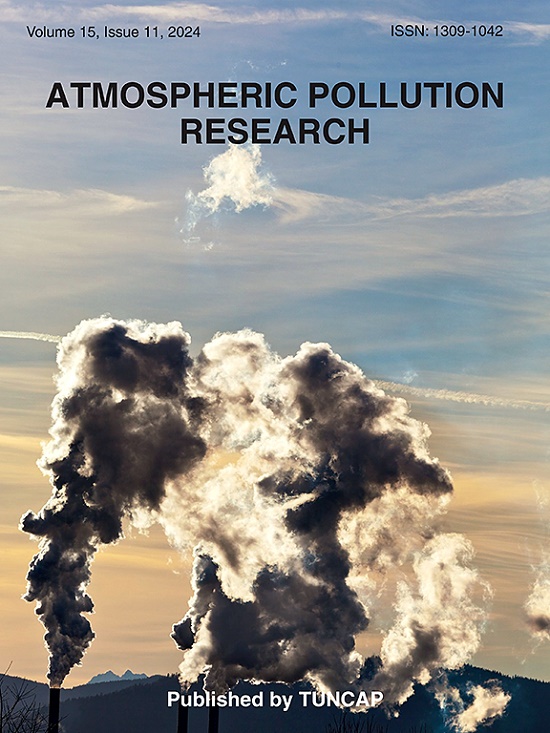Chemical composition, source apportionment of rainwater, and its contribution to nutrient deposition at an urban site of the middle Indo-Gangetic Plain region
IF 3.9
3区 环境科学与生态学
Q2 ENVIRONMENTAL SCIENCES
引用次数: 0
Abstract
The study of rainwater chemistry plays an important role in understanding scavenging processes, sources of atmospheric pollutants, and impacts on ecosystems. This study investigated the chemical composition, variations, and potential sources influencing rainwater chemistry in Varanasi, India from 2018 to 2022. A total of 158 event-based monsoonal rainwater samples were analyzed for physical (pH, EC and TDS) and major ionic species (Clˉ, Fˉ, NO3ˉ, SO42−, PO43−, Mg2+, Ca2+, NH4+, Na+ and K+). The average rainwater pH was 6.22 ± 0.45 (n = 158) with ∼92 % of the samples being alkaline with the dominance of Ca2+ and NH4+ ions, whereas the rest of the samples were acidic in nature with high SO42ˉ and NO3ˉ levels. NH4+ concentrations increased significantly until 2020, while those of Ca2+, K+, and Mg2+ initially decreased and rose after 2020. The study highlighted significant deposition of dissolved inorganic nitrogen (in the form of NO3−, NO2−, and NH4+). The average monsoonal nitrogen deposition flux was 8.04 kg ha−1 with significant contributions from NO3− (3.36) and NH4+ (4.67). In contrast, the deposition of inorganic phosphorus was significantly lower (∼0.72 kg ha−1). Thus, the rainwater deposition contributed to overall nutrient deposition, specially N and P which could significantly impact the ecosystem. Neutralization and enrichment factors indicated influences from crustal and anthropogenic sources. This is also evident from the study as ∼99 % of Ca2+ and ∼98 % of SO42− fractions were determined to be of non-marine origin. Over 800 brick kilns were identified around Varanasi and contributing to an increased NO3−, SO42− and particulate matter. The Positive Matrix Factorization (PMF) technique identified sea-salt, crustal dust, fossil fuel and biomass combustion, and agricultural emissions as potential sources of major ionic constituents over Varanasi.

印度恒河平原中部某城市雨水化学成分、来源分配及其对营养物沉积的贡献
雨水化学研究对了解雨水的清除过程、大气污染物的来源及其对生态系统的影响具有重要意义。本研究调查了2018年至2022年印度瓦拉纳西雨水化学的化学成分、变化及其潜在来源。对158个基于事件的季风雨水样品进行了物理(pH、EC和TDS)和主要离子(Cl - 2、F - 2、NO3 - 2、SO42−、PO43−、Mg2+、Ca2+、NH4+、Na+和K+)分析。雨水的平均pH值为6.22±0.45 (n = 158),其中~ 92%的样品为碱性,以Ca2+和NH4+离子为主,其余样品为酸性,SO42 +和NO3 +的含量较高。NH4+浓度在2020年前呈显著上升趋势,Ca2+、K+、Mg2+浓度在2020年后呈先下降后上升趋势。该研究强调了溶解无机氮的显著沉积(以NO3−,NO2−和NH4+的形式)。平均季风氮沉降通量为8.04 kg ha - 1,其中NO3−(3.36)和NH4+(4.67)贡献显著。相比之下,无机磷的沉积量显著降低(约0.72 kg ha−1)。因此,雨水沉降有助于整体养分沉降,特别是氮和磷,对生态系统有显著影响。中和和富集因子表明受地壳和人为源的影响。这从研究中也很明显,因为~ 99%的Ca2+和~ 98%的SO42 -馏分被确定为非海洋来源。在瓦拉纳西周围发现了800多个砖窑,这些砖窑导致NO3−、SO42−和颗粒物的增加。正矩阵分解(PMF)技术确定了海盐、地壳尘埃、化石燃料和生物质燃烧以及农业排放是瓦拉纳西主要离子成分的潜在来源。
本文章由计算机程序翻译,如有差异,请以英文原文为准。
求助全文
约1分钟内获得全文
求助全文
来源期刊

Atmospheric Pollution Research
ENVIRONMENTAL SCIENCES-
CiteScore
8.30
自引率
6.70%
发文量
256
审稿时长
36 days
期刊介绍:
Atmospheric Pollution Research (APR) is an international journal designed for the publication of articles on air pollution. Papers should present novel experimental results, theory and modeling of air pollution on local, regional, or global scales. Areas covered are research on inorganic, organic, and persistent organic air pollutants, air quality monitoring, air quality management, atmospheric dispersion and transport, air-surface (soil, water, and vegetation) exchange of pollutants, dry and wet deposition, indoor air quality, exposure assessment, health effects, satellite measurements, natural emissions, atmospheric chemistry, greenhouse gases, and effects on climate change.
 求助内容:
求助内容: 应助结果提醒方式:
应助结果提醒方式:


